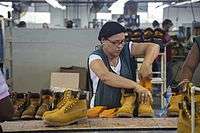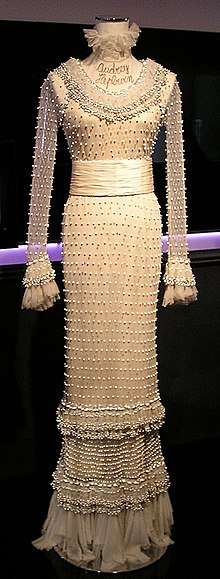Streetwear
Streetwear is a style of casual clothing which became global in the 1990s.[1] It grew from New York hip hop fashion and eventually California surfskate culture, to encompass elements of sportswear, punk and Japanese street fashion. Eventually haute couture became an influence.[2] It commonly centers on "casual, comfortable pieces such as jeans, T-shirts, baseball caps, and sneakers", and exclusivity through intentional product scarcity.[3] Enthusiasts follow particular brands and try to obtain limited edition releases.[4][5]
History
Streetwear style is generally accepted to have been born out of the New York City hip hop culture of the late 1970s and early 1980s, with elements of the Los Angeles surf culture.[6]
Early streetwear in the 1970s and 1980s also took inspiration from hip hop, the DIY aesthetic of punk, Japanese street fashion, new wave, heavy metal, and co-opting established legacy sportswear and workwear fashion brands such as Schott NYC, Dr. Martens, Kangol, Fila and Adidas.
In the late 1980s, surfboard designer Shawn Stussy began selling printed T-shirts featuring the same trademark signature he placed on his custom surfboards. Initially selling the items from his own car, Stussy expanded sales to boutiques once popularity increased.[7][8][9] Then as sales peaked, Stüssy moved into exclusive sales to create product scarcity, which firmed up the ultimate baseline definition of streetwear: T-shirts and exclusivity."[3]
In the early 1990s, burgeoning record labels associated with popular hip hop acts like Tommy Boy Records, Def Jam Recordings, and Delicious Vinyl began selling branded merchandise embroidered onto letterman jackets and workwear jackets made by companies like Carhartt.[10]
In the mid to late 90s, influences included skateboarding and gangsta rap. Professional American sports franchises having a big impact on the scene, especially the New York Yankees, Los Angeles Raiders and Chicago Bulls caps and jackets, with their production of oversized team jerseys, as well as boots from The Timberland Company and the latest shoe design releases from Nike, Inc..
Brand launches by the chief executives of record companies followed, with Russell Simmons of Def Jam launching his Phat Farm label, Sean Combs of Bad Boy with Sean John, and Jay-Z and Damon Dash of Roc-a-Fella Records launching Rocawear. Rap superstar 50 Cent a few years later launched his G-Unit clothing label, with the sneaker rights given to Reebok.
In the 2000s, the advent of "bling" culture saw established luxury brands make inroads into the market, with Burberry, Gucci and Fendi making appearances in hip hop videos and films. The most popular shoe of the era was the Nike Air Force 1, immortalized in the song by Nelly,[11] then the fashion clothing manufacturers began to follow the streetwear companies co-opting the idea of very limited edition capsule collections, now known as "drops", using social media and product scarcity as marketing tools.[12]
In the 2010s, some streetwear brands were now coveted as much as the most historically elite fashion brands. Complex Magazine named Stüssy, Supreme, and A Bathing Ape as the top streetwear brands,[3] and many went on to collaborate on prized high fashion capsule collections such as Supreme x Louis Vuitton, Fila x Fendi, A Bathing Ape x Commes des Garcons, and Stussy x Dior.[13]
In 2018, Wikipedia released two sets of long sleeve streetwear T shirts, in collaboration with LA-based brand Advisory Board Crystals and rapper Lil Wayne, with all profits going to the Wikimedia Foundation.[14][15]
Contemporary

Common sportswear worn in contemporary street styles include hoodies, bomber jackets, tennis-style skirts, track pants, leggings, and sneakers. Some of these are a revival of 1990s hip-hop fashion, which also favoured bomber jackets and baseball caps.
Contemporary streetwear is usually influenced by the generic sporty twists and sleek athletic lines. In earlier stages of sportswear fashion, femininity was usually expressed with the lines becoming cleaner, and silhouettes becoming minimal. Later, bold volumes in sportswear started to develop, hi-tech fabrics and old-school approaches were used in styling. In general, relaxed silhouettes, clean shapes, little embellishments, and an overall sophisticated feel would be observed in the looks of the trend.
Contemporary streetwear has also become much more influential in the world of haute couture influencing and in turn being influenced by runway shows by prominent designers. Raf Simons has made a large impact on streetwear stylings as it has evolved over the years, this might be attributed by the designers influence in hip hop and popular culture.[16][17] Other designers such as Demna Gvasalia, creative director of Vetements and Balenciaga, have also had an impact in recent years championing trends such as the chunky sneaker[18] and the oversized hoodie,[19] which have slowly become streetwear staples.
Luxury sportswear

The decline of formal wear led to the rise of streetwear fashion. High-end and luxury brands began to develop "luxury sportswear", for example Alexander Wang, Gucci, and DKNY. Among this type of "luxury sportswear", luxe fabrics were used to produce their sportswear fashion for a high contrast on the sporty silhouette. Fabrics like silk organza, washed satin, leather, neoprene, and wool crepe were used to produce the "luxury sportswear". These types of fabrics may help experiment a garment with texture, and may assist in capturing a modern-sports spirit of the season.
Details of the designs in "luxury sportswear" looks are pulled directly from actual active wear. The two words, "luxury" and "minimalism" were first used together for sportswear in fashion, to interpret a fresh sports look which is sleek and clean, but bearing recognizable athletic influences.
Common mix-and-match combination of "luxury sportswear" on streetwear are track pants under basketball shorts, with bold patterns and sumptuous fabrics for men; and light colored pencil skirts, with bomber jackets and sleek tops, cut in satin or tweed, for women.
Seasonal sportswear
Sportswear in streetwear designs changes according to season and temperature.
In winter, sports silhouette tends to turn slouchier and volumes are exaggerated. Solid fabrics such as fur, velvet, wool and leather become predominant, and quilted detailing on windbreakers, sporty skirts and vests can be seen. A typical winter look might be a voluminous sweatshirt with satin boxer shorts, or a brocade bomber jacket worn on top of a laid-back dress featuring mesh detailing.
In summer, the look is usually light-weight and simple, with a combination of crop tops, sleek dresses, gym-shorts, and tank-tops.
Hypebeast culture
"Hypebeast" (occasionally "hype beast") culture is a colloquial term that at first was considered a derogatory term until Kevin Ma, the founder of the original Hypebeast fashion blog, re-appropriated it to be used as the name of his fashion blog, Hypebeast.[20] Even after Ma's fashion blog expanded to a world-famous website, hypebeast still had some negative connotation.[21] Even though many hypebeasts will refer to themselves as such, taking it as a term of endearment (much like the evolution of the term otaku in Japanese popular culture circles) others still believe in the negative connotation.[22]
With a growing trend of prominent brand names and logos on clothing, there has been a development of "hypebeast culture" connected to streetwear as of the mid-2000s. Hypebeasts are defined as buying clothes and accessories simply to impress others.[23] This trend is inspired by a 1990s fashion for clothing covered in brand names and logos.[24] Hypebeasts usually wear a variety of name brands at once to boast their affluence and display popular trends.
Sneaker culture
Sneakers in streetwear accompanies a wide range of footwear. Sneaker culture is an important part of streetwear.
See also
| Look up streetwear in Wiktionary, the free dictionary. |
References
- Laux, Cameron (9 January 2019). "Who decides what is cool?". BBC designed. British Broadcasting Corporation. Retrieved 10 January 2019.
- Yotka, Steff (12 January 2019). "Think Streetwear Is a New Phenomenon? Meet Luca Benini, Who Started the Hype 30 Years Ago". Vogue. Condé Nast. Retrieved 12 January 2019.
- Hundreds, Bobby (June 21, 2011). "50 Greatest Streetwear Brands of All Time". Complex Magazine.
- Baggs, Michael (10 December 2018). "Rental fashion: How luxury streetwear is changing the industry". BBC Newsbeat. British Broadcasting Corporation. Retrieved 10 January 2019.
- "What is Street Wear?". Wisegeek.
- "How Hip-Hop Left a Lasting Influence on Streetwear & Fashion". Highsnobiety. 2018-10-02. Retrieved 2020-07-09.
- Sande, Steve (2005-11-06). "Street Threads". San Francisco Chronicle. Retrieved 2009-08-12.
- "Style: Where Surf Meets Rap". Time. 1991-02-11. Archived from the original on 2010-02-16. Retrieved 2009-09-10.
- Breinholt, Jacob (2009-08-05). "Throwback Comeback: Stussy". SoJones. Retrieved 2009-08-12.
- The Carhartt Jacket by Michel Marriott, November 29, 1992.
- Warnett, Gary (January 25, 2017). "The Forgotten History of the White on White Air Force 1, Nike's Perfect Sneaker". Complex. Retrieved January 31, 2019.
- Fowler, Damian (5 February 2018). "The hype machine: Streetwear and the business of scarcity". BBC Capital. British Broadcasting Corporation. Retrieved 10 January 2019.
- Dior x Stussy Fall 2020 by By Jonathan Sawyer, Highsnobiety, Dec 4, 2019.
- "Advisory Board Crystals Teams up With Wikipedia to Keep Knowledge Free". HYPEBEAST. Retrieved 2020-01-26.
- "Lil Wayne's New Merch Is a Wikipedia Collaboration". Pitchfork. Retrieved 2020-01-26.
- Coretti, Valerio (June 1, 2017). "Why is streetwear obsessed with Raf Simons?". nss magazine.
- https://www.youtube.com/watch?v=_eLryuBCO-M
- Caramanica, Jon (July 25, 2018). "My 8-Month Search for $900 Sneakers". New York Times.
- Fumo, Nicola (March 2, 2016). "What Is Vetements and Why Is Everyone Freaking Out?". Racked.
- Bain, Marc. "Streetwear is what happens to fashion when consumers start dictating the terms". Quartzy. Retrieved 2019-11-20.
- Weissburg, Josie. "Hypebeast Culture". The Register Forum. Retrieved 2019-11-20.
- "The Evolution of the Hypebeast: An Illustrated Guide". Complex. Retrieved 2019-11-20.
- "All Your Questios About Hypebeasts, Answered". Bustle. Retrieved 2019-09-07.
- Groce, Nia; Groce, Nia (2018-03-15). "Will the '90s Logo Trend Last? Here's What the Experts Have to Say". Footwear News. Retrieved 2019-09-07.
